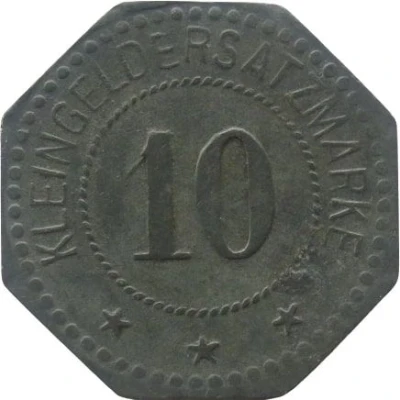


© Willem63 (CC BY-NC-SA)
5 Pfennigs - Sömmerda (Dreyse and Collenbusch) ND
| Zinc | 1.5 g | 18.9 mm |
| Issuer | City of Sömmerda (Prussian province of Saxony) |
|---|---|
| Type | Standard circulation coin |
| Value | 5 Pfennigs (5 Pfennige) (0.05) |
| Currency | Mark (1914-1924) |
| Composition | Zinc |
| Weight | 1.5 g |
| Diameter | 18.9 mm |
| Thickness | 1.0 mm |
| Shape | Octagonal (8-sided) with a hole (Hole 2mm) |
| Technique | Milled |
| Orientation | Medal alignment ↑↑ |
| Demonetized | Yes |
| Updated | 2024-10-04 |
| Numista | N#295000 |
|---|---|
| Rarity index | 97% |
Reverse
Pearl rim, legend surrounding rope circle with denomination centered
Script: Latin
Lettering:
KLEINGELDERSATZMARKE
5
★ ★ ★
Edge
Plain
Comment
Menzel: BBBFa: Munitionsfabrik und Gasanstalt
Interesting fact
The 5 Pfennigs coin from Sömmerda (Prussian province of Saxony) made of Zinc weighing 1.5 g is interesting because it was produced during a time when the Prussian government was actively trying to reduce the cost of coin production. To achieve this, they introduced a new coinage system in 1857 that used a zinc-based alloy instead of the previously used silver-based alloy. This change in material was significant because it allowed for the production of coins that were much cheaper to mint, while still maintaining their durability and resistance to wear and tear. The use of zinc in coin production became a common practice in many countries and continues to be used today in the production of many coins around the world.



